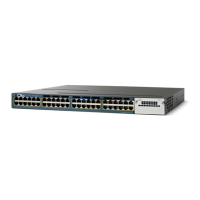1-12
Catalyst 3750-X and 3560-X Switch Software Configuration Guide
OL-25303-03
Chapter 1 Configuring IPv6 Unicast Routing
Understanding IPv6
To use the graceful restart function, a switch must be in high-availability stateful switchover (SSO) mode
(dual route processor). A switch capable of graceful restart uses it when these failures occur:
• A route processor failure that results in changeover to the standby route processor
• A planned route processor changeover to the standby route processor
The graceful restart feature requires that neighboring switches be graceful-restart aware.
For more information, see the “Implementing OSFP for IPv6” chapter in the Cisco IOS IPv6
Configuration Library on Cisco.com.
Fast Convergence: LSA and SPF Throttling
The OSPFv3 link-state advertisements (LSA) and shortest path first (SPF) throttling feature provides a
dynamic method to slow down link-state advertisement updates in OSPFv3 during times of network
instability. This feature also allows faster OSPFv3 convergence by providing LSA rate limiting in
milliseconds.
OSPFv3 previously used static timers for rate-limiting SPF calculation and LSA generation. Although
these timers are configurable, the values are specified in seconds, which poses a limitation on OSPFv3
convergence. LSA and SPF throttling achieves subsecond convergence by providing a more
sophisticated SPF and LSA rate-limiting method can react quickly to changes and also provide stability
and protection during prolonged periods of instability.
For more information, see the “Implementing OSPFv3” chapter of the Cisco IOS IPv6 Configuration
Library on Cisco.com.
Authentication Support with IPsec
To ensure that OSPF for IPv6 (OSPFv3) packets are not altered and resent to the switch, OSPFv3 packets
must be authenticated. OSPFv3 uses the IPsec secure socket API to add authentication to OSPFv3
packets. This API has been extended to provide support for IPv6.
OSPFv3 requires the use of IPsec to enable authentication. Crypto images are required to use
authentication, because only crypto images include the IPsec API needed for use with OSPFv3.
For more information, see the OSPFv3 Authentication Support with IPsec section of the Cisco IOS IPv6
Configuration Library on Cisco.com.
EIGRP IPv6
Switches running the IP services feature set support the Enhanced Interior Gateway Routing Protocol
(EIGRP) for IPv6. It is configured on the interfaces on which it runs and does not require a global IPv6
address.
Note Switches running the IP base feature set do not support any IPv6 EIGRP features, including IPv6 EIGRP
stub routing.
Before running, an instance of EIGRP IPv6 requires an implicit or explicit router ID. An implicit router
ID is derived from a local IPv4 address, so any IPv4 node always has an available router ID. However,
EIGRP IPv6 might be running in a network with only IPv6 nodes and therefore might not have an
available IPv4 router ID.

